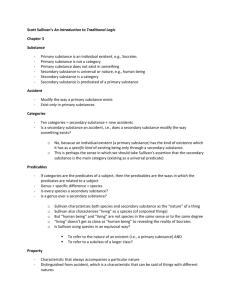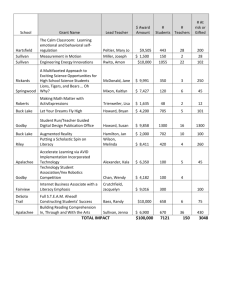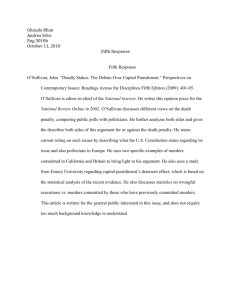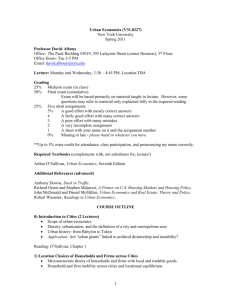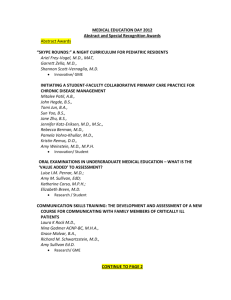Sullivan County Health Department
advertisement
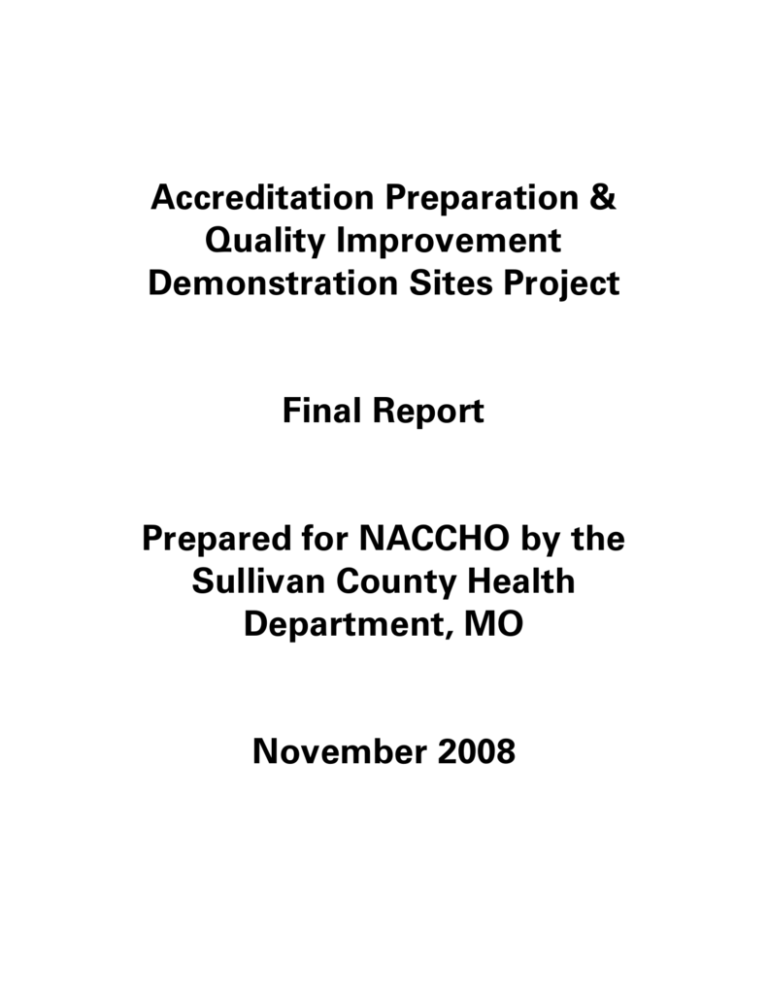
Accreditation Preparation & Quality Improvement Demonstration Sites Project Final Report Prepared for NACCHO by the Sullivan County Health Department, MO November 2008 Sullivan County Health Department Brief Summary Statement The Mercer, Putnam, Sullivan Public Health Regional Collaborative consists of 3 rural counties in northern Missouri. Mercer County Health Department is the northwest county of the region. It serves a primarily rural population of about 3,900 people including a significant Amish population. Sullivan County Health Department is in the southern county of the region. It serves a primarily rural population of about 6,800 people with a Hispanic presence. Putnam County Health Department is in the northeast section of the region. It serves a rural population of about 5,100 people with very limited diversity. Mercer and Putnam’s northern boundaries border the State of Iowa. The common gap that was identified from the aggregate results from the three health departments NACCHO LHD Self-Assessment Tool for Accreditation Preparation was Standard V-C, The need to engage in LHD strategic planning to develop a vision, mission, and guiding principles that reflect the community’s public health needs, and to prioritize services and programs. Prior to the NACCHO assessment, all three health departments had completed their own community health assessments, but had not used the information to create any form of health improvement plan. Using the results of the NACCHO assessment and the needs identified in their community assessments, a community health improvement plan was developed. This plan addresses the gap identified in Standard V-C. It also provides the capacity to communicate consistent messages about what public health is and health promotion and disease prevention education messages to the populations being served in each county. It will also help improve the health of the public as identified in the county community assessments. It includes efforts for policy development and advocacy activities which will be more effective coming from a joint effort than from three more fragmented efforts. The final effort included in the plan focuses on developing process and protocols to begin preparation for regional accreditation. Project Summary The project included each county completing the NACCHO capacity assessment. The planning process was based on the initial goal of developing a regional community health improvement plan to address cross cutting issues. Six of the indicators under Standard V-C were discussed from a regional perspective using a Force Field Analysis. Positive forces (strengths) and negative forces (Challenges) were listed under each selected indicator. Following this exercise, the group used brainstorming technique to identify stakeholders that influence regional efforts. The positive forces for completing a regional community health improvement plan far exceeded the negative. Facilitated discussion was held on the topics of social marketing (communication/education), evaluation and quality improvement, policy development and advocacy, regulatory, and education of public health partners. The participants identified that more consistent effective communication of what public health is and also of public health education messages would be a key to adding capacity in many area. The second focus area for the regional plan was public health policy and advocacy. The three participating counties are small and through joining efforts for public health policy and advocacy, they will have more impact at the policy level. And finally it was decided that the overarching area from the assessment that would add capacity for public health activity and prepare the region for future accreditation, would be the sharing or development of processes, procedures, and policies for public health programs and activities. A strategic plan was written with these three goal area. Measurable objectives and strategies were selected. Background Sullivan County is a rural county located in the north central portion of the state. The population is approximately 7,000, with the majority of residents living in the country. The town of Milan is the county seat and is home to approximately 2,000 people. Sullivan County is an agriculture and industry based community. Smithfield Farms is the largest private employer in Sullivan County. The largest school district is Milan C-2 with 33% of the students being Hispanic and over 60% of the students in the Free and Reduced Lunch Program. There are two other K-12 districts in Sullivan County, Newtown-Harris and Green City. All school districts are accredited by the Missouri Department of Elementary and Secondary Education. The following information contains the data points that I believe are important for other LHD’s. We are a county that is unique. Sullivan County has a depleting population, an increasing minority population that is extremely transient, an aging population, and an overall health rating of poor. Sullivan County is also in the poor category for health screenings, which is very concerning. This represents a low health literacy in the county. Sullivan County is home to an aging population. According to the 2003 census statistics, 18.1% of Sullivan County residents are 65 years of age or older. Sullivan County is much higher than the state average of 13.3% (www.oseda.missouri.edu). In addition, the county rate for people under age 18 was 23.8%, while the state rate was 24.7%. There was a 6.0 % decrease in population between 2000 and 2006. This has been a trend since the 1990s and is expected to continue through 2010. Contributing factors leading to this are more deaths than births during this period along with a high transient population. Race and ethnicity changes a great deal Sullivan County. Census data for 1990 showed a .1% Hispanic population, this percentage increased to 11.8% in 2005. There does appear to be a trend in census figures with regard to special population groups. Kids Count 2006 data indicates that Sullivan County has remained significantly higher in percentage of children eligible for free and reduced price lunch when compared to the state of Missouri. During the time frame of 2001-2005 Sullivan County had a 62.5% free and reduced lunch program compared to Missouri’s state average of 41.7%. During the same time period, the percentage of births to mothers with less than a high-school education in Sullivan County was 40.2, while the Missouri’s average was 18.6. The averages for Sullivan County for children under 18 receiving Medicaid was 47.3%, compared to Missouri’s average of 36.6%. Sullivan County’s averages are well above the state’s averages. Poor health status is directly correlated to economic status and our county represents a low economic county. The average annual salary in Sullivan County (Kids Count 2005) was $27,805 compared with a state average of $34,356. These figures vary little from 2002. Unemployment in Sullivan County was 6.1 compared to the state of Missouri’s average of 5.4. There were approximately 3,500 people in the workforce in 2000. Of those, 2,300 commuted alone, 136 walked, and 220 worked at home. 1,900 of the workers held an occupation is production and manufacturing. Smithfield Farms, formerly known as Premium Standard Farms, employs a majority of this population. Sullivan County had over 1,100 and 23% of the children under the poverty line in 2000. According to 2000 Census figures, 39% of houses in Sullivan County were built prior to 1939, and 31% prior to 1979. These houses are located throughout the county, but because Milan, the county seat, is the most populous area, the majority of houses are located in that city. A large number of people also live in older farm houses in the county. The crime rates in Sullivan County for homicide, assault, juvenile crime, and violent crime have increased but are still lower than the averages for the state of Missouri (Census 2000). There is little variance in rates from 2000 to 2003. There is, however, a dramatic increase in the rates for methamphetamine lab incidents, going from only four in 2001 and six in 2002 to 34 in 2003. Drug arrests have also risen from 42 in 2001, 37 in 2002, to 62 in 2003. Drug-involved traffic accidents increased from one in 2001, two in 2002, to four in 2003. Drug-related hospitalizations or emergency room visits went from 35 in 2001 and 24 in 2002 to 49 in 2003. According to Kids Count 2005 Sullivan County has remained lower than the state for child abuse/family assessment per 1000 for each of the years 2002-2004 (Sullivan County = 38.3; Missouri = 40.5). For the same time period, out-of-home placements per 1000 was higher (Sullivan County = 6.1; Missouri = 4.8). Juvenile crime offences decreased from 36 in 2001 to 20 in 2003 (Missouri Department of Mental Health. Incidents of domestic violence have increased in Sullivan County over the past four years (Crime in Missouri, 2004) (Missouri Department of Mental Health). Domestic violence reports went an average of 13 to 31 in 2003. Prison admissions also rose from 14 to 23 during the same time period. Unintentional injuries in Sullivan County are higher than the state rates as well as those for some of the neighboring counties. According to Department of Health & Senior Services statistics, between 1994 and 2003, Sullivan County had significantly different (higher) rates than the state in ER visits (total unintentional injury 1,600+ in 2005), and ER visits for falls, poisoning, drugs/alcohol, and burns. Sullivan County was in the first quintile for total ER visits, poisonings, and burns, and the first quintile for drug/alcohol and falls. The Sullivan County trend rate shows a steady increase of ER visits and injuries. When compared to the state for maternal and child health indicators (Kids Count 2005, MICA), Sullivan County is higher than the state rate for percent of births to mothers without a high school diploma (SC = 40.2, MO = 18.6), births to teens (SC = 77.3, MO = 43.4), and children who are on Medicaid (SC =48.3, MO = 41.1; seven days, GC = 42.7, MO = 26.2). There are a number of prenatal risks associated with the Hispanic population. These include birth to teens, births to mothers with less than a high school education (their education is complete following the eighth grade), late or no prenatal care (most do seek the care of their lay-midwife), and inadequate birth spacing. These are cultural barriers that are very difficult to broach with Hispanic families and birth outcomes do not appear to be adversely affected. Behavioral risk factors such as tobacco use, physical inactivity, and obesity contribute to chronic disease rates in Sullivan County. According to the 2003 Health and Preventive Practices Status Report (DHSS), the county prevalence for the health status rating of “fair or poor” was 23.4%, while the state prevalence rate was 16.9%. Behavioral risk factors prevalence rates for physical inactivity, current smoker, and overweight were all slightly above the state prevalence rates. Sullivan County is above or equal the state rate for most chronic disease indicators (2003 Health and Preventive Practices Status) as shown in the prevalence of such health problems as high blood pressure (SC = 31.6%, MO = 28.5%), high cholesterol in ages 35 years and older (SC = 42.1%, MO = 37.3%), asthma (SC = 10.1%, MO = 10.7%), and diabetes (SC = 7.0%, MO = 7.2%). Screenings for early detection and diagnosis of diseases are not utilized to an optimal degree. As shown in the 2003 Health and Preventive Practices Status Report (DHSS), Sullivan County is higher than the state rate for women over 70 who have never had a pap test (SC = 8.0, MO = 6.4). For both men and women over 50, Sullivan County is significantly higher for those who have not had a blood stool test in the last year (SC =81.1, MO = 77.5), and never had a sigmoidoscopy or colonoscopy or have not had one in the past five years (SC = 69.1, MO = 57.0). The screening that concerns me the most is the number of women that have never had a mammogram compared to this state. Sullivan County is in the High category at 26.5% compared to Missouri’s 13.4%. The mortality rate in 2005 for Sullivan County for heart disease was significantly higher than the state of Missouri. Heart disease accounted for 30% of the total deaths in Sullivan County and the trend shows it to be increasing. Higher rates of mortality are consistent with behavioral risk factors. In addition, they are consistent with rates of screening tests for early detection and risk factors such as high blood pressure and high cholesterol. There are three physicians practicing in Sullivan County along with two nurse practitioners. This is a low number for the size of the county. With the migrant Hispanic population a translator is essential in our community. All providers currently accept Medicaid coverage, but I could see that changing in the future. Because Sullivan County is primarily rural, transportation is sometimes a barrier in seeking care. A lack of health insurance is starting to be come a problem is receiving health care as well. The largest health care resource gap in Sullivan County is access to medical care without insurance and the amount of women that have not had a mammogram. The three counties have a long history of teamwork. The three participate in monthly administrator meetings in Grundy County with several other health departments. Additionally, the three health departments are members of the Mercer-Sullivan- Putnam Network, whose mission is to collaborate with community partners in all three counties to implement projects and obtain resources with the goal of making the counties a healthier place. The network is a 501(c) 3 non profit organization. Other collaborative efforts include Sullivan/Putman sharing a nurse and Sullivan and Mercer collaborating with Linn County for the provision of environmental services. It is imperative that resources be pooled to benefit the communities in the region due to the low multi-county household average income of only $30,642 and low population numbers. With limited resources it is impossible for each county to provide the ten essential services for the entire population. In addition, the three counties feel that collaboration will provide the best opportunity for achieving the necessary capacity to attain future accreditation. Goals and Objectives Initially the collaborative selected the goal of developing a health improvement plan (Standard V-C). This remained the overall NACCHO project goal throughout the planning process. However, the project goal for inclusion in the first Charter was taken developed from the health improvement plan. The goal for the Charter was selected so the region would have a project that was manageable and attainable in a reasonable amount of time, The Charter goal is “To have a communication plan to educate the public, public health partners, governing bodies, and legislature about the role of public health.” Because the regional health departments are committed to an ongoing long term relationship, a long term goal for the collaborative was created. It is “to have a regional system that will help provide the capacity for each local health department in the collaborative to perform the Ten Essential Services of Public Health.” Self-Assessment The Sullivan County Health Department staff met multiple times to discuss priority areas along with the self assessment process. The staff included the administrator, 1 environmentalist, 1 bookkeeper/secretary, 4 nurses, 1 WIC/billing/supply clerk, 1 translator/billing clerk, and 1 epidemiologist. The administrator made the final decision based on the employees’ input. There was little contention. The employees were all informed of the final decisions and were all in agreement. The administrator entered the data on the questionnaire. The staff met three times and spent a total of 3 hours discussing the assessment process and identifying priority areas. The online tool compiled the three county results. When the three collaborating County Administrators met, we reviewed the collaborative scores and agreed on Standard V-C as our area of focus without difficulty, as it was a low indicator area for each of the three health departments. Standard/ Indicator # V-C V-B. 3 & 4 I.A Highlights from Self-Assessment Results Standard and Significance LHD role in implementing community health improvement plan • In the aggregate data for the three counties, this standard was one of the lowest. Even though each county had completed a community health assessment, they had not done any health improvement planning. Therefore they felt this was a good way to start filling the gaps as a region 3. LHD engages partners in policy development process and LHD legislative agenda 4. LHD conducts advocacy at all levels that protect and promote the public’s health • These two indicators demonstrated the need for the collaborative to more proactive and engaged in policy and advocacy. This was one of the areas included in the regional community health improvement plan Ata Collection, Processing and Maintenance • The collaborative demonstrated adequate capacity for all of the indicators under this standard. Capacity in this area provides a strong base for much of what pubic health does Collaboration Mechanism The three participating health departments have a long successful working relationship. There were no turf issues and everyone was cooperative and enthusiastic about working together on capacity building activities. It was therefore decided to create a generic Memorandum of Understanding for all activities that would build capacity across the region. The details of specific projects would be placed in a Charter. There were no other mechanisms considered as the collaboration had already been working under other Memorandums of Understanding for other projects and felt the Memorandum of Understanding and Charter combination was effective way to work through a variety of projects over time. In Missouri each health director has the authority to sign interagency agreements such as the MOU and Charter, as long as it is promoting the health of the populations being served. The Boards of Trustees do not sign these agreements. The directors update the Trustees on what activities they are working on and collaborative efforts such at this project. Because the directors have the authority to sign the agreements and work within the collaborative, there were no legal issues in developing the organizational structure. All members of the collaborative work very well together and felt this collaborative effort was critical to filling gaps in their capacity and also preparing them for accreditation. There were no barriers to working together and the members understand they will have to access dollars for some of the activities. They are very willing to share resources when it is possible to get added benefit from a collaborative effort. It is understood that planning to accomplish goals using the efforts of three departments vs. each department working independently to accomplish the same goal is a win-win situation. Accountability is addressed in the Charter with the following statement. “The activities undertaken through this charter and related Memorandum of Understanding will be reported to the participating Boards of Trustees, each local health department and the populations being served.” Also, the MOU identifies the responsibility of the fiscal and administrative entity for projects. The Memorandum of Understanding specifies the decision making structure. A committee consisting of all three health directors will determine the projects to be undertaken and which department will serve as fiscal and administrative agent. The committee will complete a budget, business, and work plan for each project. The work plan will include who will be responsible for the activities including coordination and oversight of the project. Results We have not yet had an opportunity to implement the formal mechanism of collaboration, however that does not minimize our success at this point. By having the MOU and charter in place we now have the framework necessary to move forward. By design, the MOU is much broader so that we can continue to work collaboratively in the future with a clear agreement already in place while the charter is more specific to separate projects. This is different by the past MOUs only involved emergency management plans. This formally binds us to a collaboration in addressing our regions health concerns. We have already outlined a specific charter: Communicating the Role of Public Health. By working on this regionally we will be able to maximize outputs and not reinvent the wheel. We hope to standardize the public health message across our three counties. There is minimal media coverage in our area therefore this is very important. Newspapers in each of the counties are only disseminated once weekly, television coverage is minimal, and radio coverage does not come directly from any of the three counties in which our health departments reside. The charter format can then easily continue to be adapted to additional specific projects in the future. The charter has given us a formal agreement as mentioned earlier, which also opens up resources made available to all of us and will aid in applying for a 501c3. The unanticipated benefits from the individual and aggregate assessment were many. On an individual basis it prompted our staff to consider strengths and weaknesses as we had not before. We were able to identify areas of improvement such as social marketing, quality assurance, and customer service. It helped the Sullivan County Health Department staff understand what accreditation truly involves and to think out side of the box in their own jobs. I, the administrator, think the same held true for the collaborative. While in several of the areas our strengths and weakness were similar we were able to identify where one health department may already have a best practice that could be replicated. Lessons Learned The self-assessment was a wonderful tool that. It’s a tool that could be used in many areas of business. It was a user-friendly tool that helped us point out some our strengths and weaknesses. It forced us to spend time and analyze our agency. I hope the tool will continue to be offered online for free. I believe that working as a collaboration increased the value of what we have done. It is necessary for rural agencies to collaborate and pool resources and this was a great opportunity to do that. Recommendations for other LHDs would be to set aside to time to work on the assessment and do it with the entire agency (if possible), choose health department or agencies that have resources that can be mutually beneficial, geographically accessible, and have similar goals and objectives. I would also recommend to approach the entire process with an open mind, but also be prepared to speak their idea, because a true collaboration need everyone’s input and ideas. Next Steps The Missouri Institute for Community Health (MICH) chose our collaborative and a pilot in their accreditation process. MICH sent me to Minneapolis for the MLC3 kickoff and accreditation meeting. I had the opportunity to learn from many different state leaders and also came to the realization that Missouri is one of the state leaders in the accreditation process. Because of the MOU and Charter we have tools in place to build on what we have done and expand it. One of the goals of the mini-collaborative is to achieve state accreditation in the next two years. If this is accomplished, we will only be that much closer to achieving national accreditation. Conclusions Participating in the accreditation preparation demonstration sites project has given the Sullivan County Health Department the boost we needed to start working towards state and national accreditation. Having a consultant we would have not otherwise been able to afford to guide this process was instrumental. Our consultant helped us digest our area of improvement in a more tangible way and expedite our discussions toward real results. Networking and discussion among the administrators was extremely important as was in the increased awareness of accreditation and quality improvement by our governing body. I would recommend the tools used by NACCHO during this project to any health department. If others are unable to fund a consultant a recommendation would be to appoint a facilitator who is charged with keeping all parties on task and moving forward during meetings. Some useful tools that the consultant used which could be prepared by someone internal to a local health department includes: agendas for meetings, recording “strengths and challenges” as they relate to specific priority topic areas or indicators, and recording stakeholders from brainstorming sessions that will have an influence on efforts. Our consultant also prepared a “Crosswalk of Issues” which highlighted issues from the assessment and the presented individual issues from each participating county in a table format.

